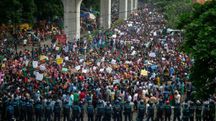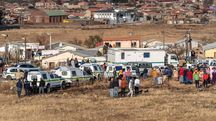Typhoon ‘Nanmadol’ hits Japan, millions asked to evacuate
As per the Japan Meteorological Agency, Typhoon Nanmadol was near the southern island of Yakushima, packing maximum surface winds of 162 kilometres (101 miles) per hour, as it slowly headed north to the country's main southern island of Kyushu, where it could make landfall later on Sunday.
 Typhoon ‘Nanmadol’ hits Japan
Typhoon ‘Nanmadol’ hits JapanA powerful typhoon approaching southern Japan pounded the region with strong winds and heavy rain on September 18, causing blackouts, paralysing ground and air transportation, and the evacuation of thousands of people.
As per the Japan Meteorological Agency, Typhoon Nanmadol was near the southern island of Yakushima, packing maximum surface winds of 162 kilometres (101 miles) per hour, as it slowly headed north to the country's main southern island of Kyushu, where it could make landfall later on Sunday.
Nanmadol is forecast to turn east and reach Tokyo on Tuesday.
By midday on Monday, the service predicted up to 50 centimetres (20 inches) of rain, issuing a flood and landslide alert.
Additionally, the government advised residents to evacuate as soon as possible due to "unprecedented" levels of strong winds and waves. No significant casualties or damage have been reported by local authorities so far.
As per the report, more than 9,000 inhabitants of the severely affected Kagoshima prefecture took shelter at evacuation centres on Sunday.
Another 4,700 people were relocated to the neighbouring Miyazaki prefecture and more than 93,000 residences on the Kyushu island were reported to be without electricity on Sunday as a result of damage to power cables and infrastructure by Kyushu Electric Power Co.
Meanwhile, Japan Airlines plans to cancel 376 flights. Through Monday, other airlines are also suspending operations, mostly on routes that serve airports in the Kyushu and Shikoku areas.
In addition to this, services provided by bullet trains have also been affected.
More than 14,000 people in the city of Nishinoomote on Kyushu island were given a level five alert, the highest warning possible under Japan's disaster warning system.
Copyright©2025 Living Media India Limited. For reprint rights: Syndications Today









